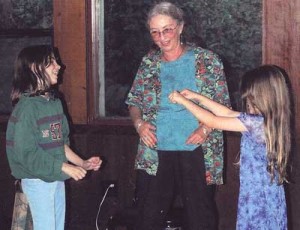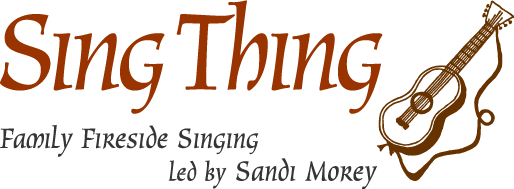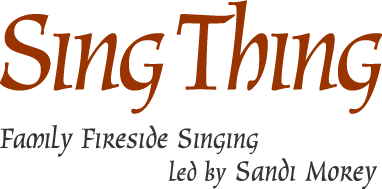Welcome to the family of Sing Thing Family Singing. Here’s a bit about the group — we’ve been going for more than four decades!

Sing Thing began in April, 1975, in the back room of Robin Goodfellow’s home-studio in Oakland. Within 6 months, it had grown and moved into larger quarters. One of the neighbors who came in that early time named the group Sing Thing. The name stuck.
I moved to Oakland from San Francisco in 1977, and have hosted the Oakland group in my living room ever since. In 1982, Rina Margolin (wife of Malcolm) started the Berkeley group and in 1986, the Gutfreund family started the group in San Francisco.
I began Sing Thing for my own enjoyment. As a kid, I was lucky enough to be a camper at YWCA Camp Timbertall, a creative arts camp, open to all races, all economic groups (lots of camperships), and all religions. Timbertall was directed by an Oakland woman, Emelita Cohen — of the Cohen family whose preserved 19th Century Cohen Bray House is an Oakland treasure — who had a strong connection with Mills College. Because of that, our camp counselors came from all over the world. They brought with them songs from all their cultures and taught us some beautiful music. I consider that the greatest gift I could ever have been given. I amassed a repertoire of hundreds of songs and rounds from just about everywhere.
Sing Thing Season, Location & Time
Weekly Thursday Night Group
in Oakland: 3461 Laguna Avenue (near Fruitvale & MacArthur)
In my twenties, I youth-hosteled around Europe, and I made a discovery that surprised me. I was able to sing rounds and alpine songs with the large European groups that came through the hostels. I was the only American to be able to do so, although young people from all other countries knew these songs. I started Sing Thing so I could have others to sing with and I loved these songs so much I wanted Americans to be able to sing them, too. I also teach traditional folk songs, ballads, and sea shanteys that I have loved and collected since I was little. Over the years, Sing Thing members, including the children, have also brought lovely songs to us.
In Sing Thing, you will learn rounds, part-singing, songs in a variety of languages from a variety of cultures, sea shanteys, work songs, and songs that are just plain fun to sing. What you will not learn here is what used to be called “bus songs.” These are songs that are often taught at camp now. There are lots of these, and believe me, your kids will learn them elsewhere. Examples: On Top of Spaghetti, 99 Bottles of Beer, The Ants Go Marching, Found a Peanut, etc. My rule of thumb is — if they’re gonna learn it someplace anyhow, I’m not going to teach it in Sing Thing. What they’ll learn in Sing Thing they won’t find anyplace else.
Although I began Sing Thing for myself, I have noticed that it fills a community need. For some kids, it’s the only music they have, due to withdrawal of funding for music from the public schools. For some, it is a first step in budding musical careers (check out Michael Bannett). There are Sing Thing alumni in youth orchestras and children’s choruses, the Berkeley Gilbert & Sullivan program, Interfaith Gospel Choir, and we have even had some college music majors.
I have noticed that singing in harmony contributes to the ability to live in harmony. — Sandi Morey
 Sing Thing is purely for relaxation and enjoyment. I do not stress technique or set up performances for the group. There is no stress connected with Sing Thing and the skills and repertoire are built through having fun singing together. It is as much a group for the adults as it is a group for the children. I have found that if the adults enjoy singing and each other’s company, the children will, too. The songs may be unfamiliar to them at first, and they may need a little time to get comfortable with the songs and the other families before they feel ready to participate. They may be a bit shy if they don’t know anyone yet. This is completely normal, and I don’t worry about it if they don’t sing for a while. (Michael Bannett didn’t sing for a couple of years, and then at 13, had several CDs out!) As long as your child doesn’t disturb others and can handle a rather structured hour-long session, it is perfectly okay for her/him to not join in. Sometimes little ones fall asleep on the rug and spend the whole year doing just that. Guess what? When they mature enough to stay awake, they know all the songs they slept through. Feel free to bring them in their jammies, with teeth brushed. Just drop them into bed when you get home. Easy!
Sing Thing is purely for relaxation and enjoyment. I do not stress technique or set up performances for the group. There is no stress connected with Sing Thing and the skills and repertoire are built through having fun singing together. It is as much a group for the adults as it is a group for the children. I have found that if the adults enjoy singing and each other’s company, the children will, too. The songs may be unfamiliar to them at first, and they may need a little time to get comfortable with the songs and the other families before they feel ready to participate. They may be a bit shy if they don’t know anyone yet. This is completely normal, and I don’t worry about it if they don’t sing for a while. (Michael Bannett didn’t sing for a couple of years, and then at 13, had several CDs out!) As long as your child doesn’t disturb others and can handle a rather structured hour-long session, it is perfectly okay for her/him to not join in. Sometimes little ones fall asleep on the rug and spend the whole year doing just that. Guess what? When they mature enough to stay awake, they know all the songs they slept through. Feel free to bring them in their jammies, with teeth brushed. Just drop them into bed when you get home. Easy!
 Much of the music I teach is adult music. It is really for everyone and appeals to a broad age range. That is the beauty of traditional folk music. You will notice that your kids learn it faster than you do. Not to worry! You have lots of things to keep track of that take up space in your brain. Kids are sponges for everything (including TV commercials). I recommend that you enlist their help in learning the songs. Do bring a recording device and play the recordings in the car. Sing on commutes, trips, and so on. It passes the time most pleasantly and I have noticed that singing in harmony contributes to the ability to live in harmony.
Much of the music I teach is adult music. It is really for everyone and appeals to a broad age range. That is the beauty of traditional folk music. You will notice that your kids learn it faster than you do. Not to worry! You have lots of things to keep track of that take up space in your brain. Kids are sponges for everything (including TV commercials). I recommend that you enlist their help in learning the songs. Do bring a recording device and play the recordings in the car. Sing on commutes, trips, and so on. It passes the time most pleasantly and I have noticed that singing in harmony contributes to the ability to live in harmony.
Each season, each group chooses its Top Ten Favorites.
Sandi Morey also hosts Summer Sing for Grownups for 6 weeks each July – August.


